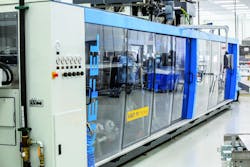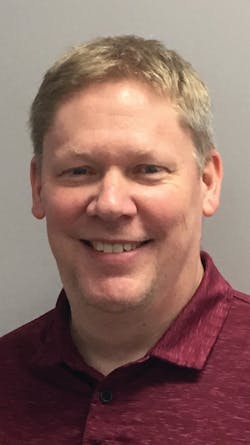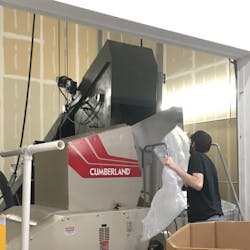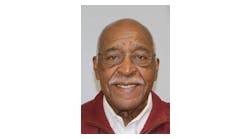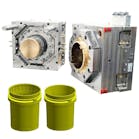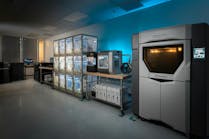A Kiefel KMD 90 pressure formerT.O. PlasticsThermoformer T.O. Plastics offers an unusual product mix. In one of its factories, the Clearwater, Minn.-based company forms thin-gauge horticultural products, such as square plant pots, containers for plug and propagation trays, as well as heavy-gauge products, such as returnable dunnage and housing enclosures made from PE, PC, PET and acrylics. In its other plant, located in Otsego, Minn., machines form medical packaging such as blister packaging, clamshells and trays.
During a recent Plastics Machinery Magazine visit, an employee was sonic-welding air vents into enclosures to house mice for medical testing. The company forms the containers, measuring 9 inches by 15 inches by 5 inches deep, from amorphous PET on a Brown thermoforming line.
Mice, after all, must breathe to make their contributions to medical science, and this plastics operation provides the sonic welding that makes that possible.
T.O.’s portfolio of machinery is as varied as the end products it produces. It boasts a range of equipment — 3-D printers and extruders, as well as the sonic welders — that might surprise some observers.
Officials identify a Kiefel KMD 90 pressure former line that was added last year as the company’s most innovative and state-of-the-art. Housed in a Class 100,000 clean room, it produces packaging for medical devices.
David Richards, director of operationsPMM“It’s a more modern machine line,” said David Richards, director of operations. “It allows for quick-change-type setups. The speed on it is much, much faster. It can process a wide range of materials and produce a wide range of gauges. It’s just a better machine, just because it’s more modern.”
According to Kiefel, the pressure former has a maximum forming area of 34 inches by 36 inches, and its clamping pressure is 44 tons, with forming pressure of up to 75 psi. The machine primarily processes styrene and PET roll stock. A touch-screen HMI makes the machine user-friendly.
“Most of the changes you do are all done at the control panel,” Richards said. “While on older machines, you twisted dials, you’re having to get a wrench to go in and make some adjustments. This is almost exclusively all controlled from the panel.”
Generally, T.O. runs three to six cavities on the machine, which has automatic stacking. The largest part that can be formed is 34 inches by 35 inches. “You can not only form it, you can trim it, you can also stack it,” Richards said. “The idea is that when it is feeding to the operators, they do not have to stack the parts. They just take them and pack them at that point. It’s a really nice feature. None of our other machines in either facility has automated stacking.”
THERMOFORMING AT ITS CORE
Thermoforming is T.O.’s bailiwick, and it traces that expertise to its founding in 1948 by Ted Ingersoll and Oren Beech, whose first initials form the company’s name. The business partners thermoformed their first parts in the garage and basement of Beech’s Minneapolis home, according to the company. Today, T.O. is owned by Otter Tail Corp., a publicly held company with dual headquarters in Fergus Falls, Minn., and Fargo, N.D.
In the 1960s, one of T.O.’s biggest customers was Frigidaire, said Amber Laudenbach, T.O.’s marketing manager. “That is where we expanded our product offering for the industrial space. This gave us a solid reputation in the market for having outstanding quality and service.”
The company moved into the medical market through its acquisition of another company, said Don Jaeger, VP of sales and marketing, and has been focused on its growth. “We’ve moved the needle a lot, working with the smaller companies, the smaller startups, the med-techs, the medium-sized medical device OEMs. These companies might need all these different things. They might need more of an R&D partner. We have a diverse set of capabilities where it’s better consolidation. We try to emphasize that we like custom jobs. Some companies don’t, because custom jobs mean complexity. But that is what we’re good at. And we stand behind our tagline that we are your plastics partner.”
To that end, the company is equipped with nine thermoforming lines in Clearwater for producing horticultural products; three rotary formers; and two inline formers for industrial products. The thermoformers are a mix of Brown and Lyle brands. In Otsego, the company operates seven inline and four sheet-fed formers. One of the inline machines is the recently installed Kiefel, and the others are Browns.
Material management is key; officials emphasized sustainability. Regrinding and recycling are embedded in the culture. That is highlighted by the large number of material conveying systems built into the floor under the thermoforming lines — that is how the scrap is carried to a suite of grinders, in all makes and models.
At the Otsego site, four grinders are at work — three inline and one offline. Clearwater has 10, seven inline and three offline.
In custom work, fast changeover times are critical. T.O. officials know that and embrace it. Richards said that is a compelling feature of the Kiefel KMD.
“We have a lot of really good equipment that has been here for quite a while,” Richards explained. “They are sturdy pieces of equipment that we have been very successful with. When they were built, it wasn’t as much with changeovers in mind, while some of the more modern-type equipment, if you can reduce a changeover from three hours to 10 minutes, that is a big deal. The Kiefel really allows quick-time changeovers.”
The mix of primary machines reflects the amalgamation of factors T.O. officials consider in making equipment-acquisition decisions. Chief among them is considering what customers need. But tooling requirements also play a significant role.
“We have a lot of tools that have been running for 10 years,” Richards said. “If you’re looking at new equipment, then you want to make sure your tooling is going to be able to fit in that. You tend to get a little streamlined in some of those machinery choices simply because you cannot just go out and buy a new piece of equipment, because then you have to retool everything. The retooling can come at a higher cost than the original machinery at that point. You have to make sure you are taking everything into consideration.”
The evolution in controls has made processing much more user-friendly, and officials see plenty of opportunity for thermoforming. A lot of it revolves around the amount of progress OEMs have made in terms of controlling position, temperature and process.
“There are significant opportunities yet within the thermoforming world of where the machines can go with controls in terms of how you get better process control, etc.,” Richards said. He is optimistic that control systems will continue to improve. “The Kiefel is definitely a step up over many of our machines, but there still is a lot of opportunity out there.”
To support its thermoforming operations, T.O. extrudes its own sheet, including utility-grade, high-impact PS and ABS roll stock. Extrusion currently is housed in the headquarters facility in Clearwater, but the company will add extrusion capacity to the Otsego factory next year, said Kevin Kieke, director of engineering and quality. The company recently acquired more industrial space that will add another 30,000 square feet, bringing the total to 90,000 square feet. The company’s largest sheet extrusion line is from Processing Technologies International (PTi), and it is supported by a Conair materials-handling system. Another line coextrudes sheet and is made up of one extruder from Davis-Standard and another from Welex.
“Not 100 percent, but it’s probably north of 90 percent of all the material that we use in Clearwater, is extruded in Clearwater,” Richards said. “Then a smaller portion, probably 20 percent of what we use at this [the Otsego] facility, is all extruded in Clearwater also.”
INVESTMENTS ON THE HORIZON
Thermoforming doesn’t quite lend itself to automation as much as processes like blow molding or injection molding; however, that isn’t stopping T.O. from exploring its options, especially as it contends with the current labor shortage.
“We are in the early stages of defining our automation vision,” Kieke said. “We have very recently kicked off an automation project that we intend to start deploying beginning in about six months to start doing a fair to significant amount of automation within our horticulture production.”
The project could potentially include automatic part counting, inspection, case packing and palletizing.
An employee uses a Cumberland grinder.PMMThe company began working with 3-D printing in 2009, finding that the process presented a way to model designs and build some prototype molds. In the early stages of development, a customer might not be able to truly gauge packaging requirements because the product that the packaging would enclose hasn’t yet been made. In that regard, if T.O. is making a change to a package, a customer might want to see how the product for the package fits before beginning final mold development.
“We will print up a model of a customer’s apparatus or component that goes in the package, or we will print a model of a mating part where we can do some comparison and/or show the customer if there are any issues or concerns with the design,” Kieke said.
The printers that have been behind all this work are a Stratasys Fortus 400 and a Dimension SNF200CS. Kieke said the company is planning an upgrade to one of the printers.
“A lot of that discussion centers around how do we use the tool to better service our customers?” he said. “Then, also, the types of materials that the printers are able to process. The printer that we are trading off is [nearly] 11 years old; it served its purpose, but there has been such a change in that technology, in terms of the different types of materials that are able to be printed, and on the structural integrity of the prints themselves, that it was time to look at an upgrade so that we could offer a wider range of materials in some of our testing.”
But the company also prints products for internal purposes, too. “We’re using the printers to create manufacturing aids,” he said. “There are cases where because of [machinery] startups, and lower volumes, we do a fair amount of manual trimming. Some of our parts are very symmetrical. So, we have aids that are part of our tooling that we are able to print in such a way that it makes it more intuitive for operators so they can’t put a part in upside down or backwards, for example. It is to give our operators manufacturing aids so that they have less likelihood to make mistakes.”
Angie DeRosa, managing editor
Contact:
T.O. Plastics Clearwater, Minn., 320-558-2407,
